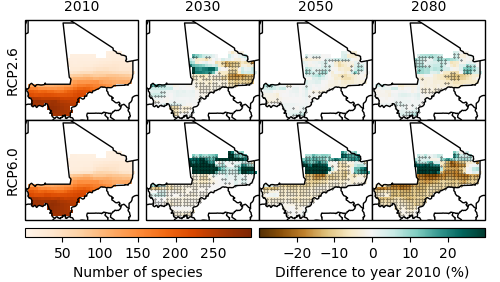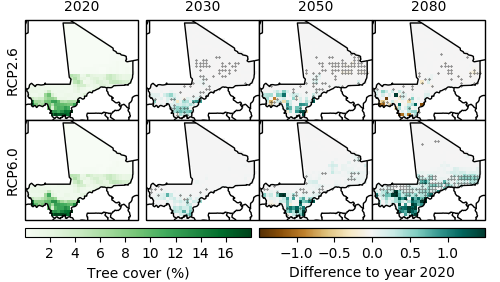Mali: Ecosystems
Climate change is expected to have a significant influence on the ecology and distribution of tropical ecosystems, though the magnitude, rate and direction of these changes are uncertain [28]. With rising temperatures and increased frequency and intensity of droughts, wetlands and riverine systems are increasingly at risk of being converted to other ecosystems, with plants being succeeded and animals losing habitats. Increased temperatures and droughts can also impact succession in forest systems while concurrently increasing the risk of invasive species, all of which affect ecosystems.
Species richness

Model projections of species richness (including amphibians, birds and mammals) and tree cover for Mali are shown in Figure 15 and 16, respectively. Under RCP6.0, species richness is projected to decrease by 10 % in the southern half of Mali by 2080 compared to the year 2000. In the centre, however, species richness is projected to increase by up to 30 % (Figure 15). All models agree on this trend.
Tree cover

In terms of tree cover, model agreement is lower: Models project increases in tree cover of up to 1.5 % in parts of southern Mali under RCP6.0 (Figure 16). Projections of both species richness and tree cover under RCP2.6 are subject to high modelling uncertainty.
Although these results suggest a positive picture for climate change impacts on tree cover, it is important to keep in mind that the model projections exclude any impacts on biodiversity loss from human activities such as land use, which have been responsible for significant losses of global biodiversity in the past, and are expected to remain its main driver in the future [29]. For example, rapid growth of agricultural production and logging have resulted in high rates of deforestation: Mali has lost 330 000 ha of forest cover in the period from 2001 to 2018, which is equivalent to a 13 % decrease since 2000 [30]. Given Mali’s rapid population growth, this trend is likely to continue and will impact animal and plant biodiversity.
References
[28] T. M. Shanahan, K. A. Hughen, N. P. McKay, J. T. Overpeck, C. A. Scholz, W. D. Gosling, D. William, C. S. Miller, J. A. Peck, J. W. King, and C. W. Heil, “CO2 and Fire Influence Tropical Ecosystem Stability in Response to Climate Change,” Nat. Publ. Gr., no. July, pp. 1–8, 2016.
[29] IPBES, “Report of the Plenary of the Intergovernmental Science-Policy Platform on Biodiversity and Ecosystem Services on the Work of Its Seventh Session,” n.p., 2019.
[30] Global Forest Watch, “Mali.” Online available: https://www.globalforestwatch.org [Accessed: 25-Feb-2020].


